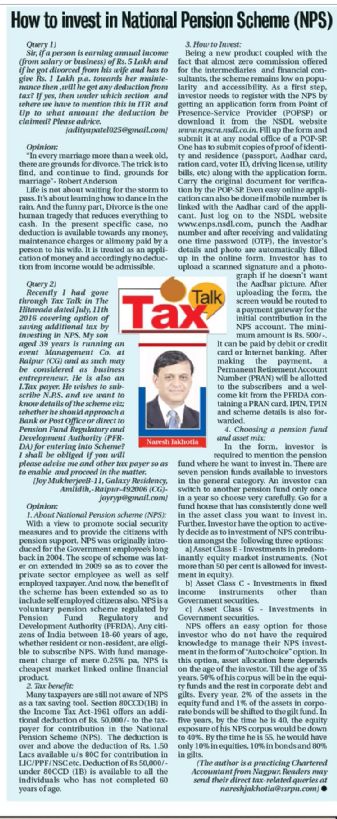|
|
| Article Details |
|
|
How to invest in National Pension Scheme (NPS) |

TAX TALK-19.09.2016-THE HITAVADA
TAX TALK
CA. NARESH JAKHOTIA
Chartered Accountant
How to invest in National Pension Scheme (NPS)
Query 1]
Sir, if a person is earning annual income (from salary or business) of Rs. 5 Lakh and if he got divorced from his wife and has to give Rs. 1 Lakh p.a. towards her maintenance then ,will he get any deduction from tax? If yes, then under which section & where we have to mention this in ITR & Up to what amount the deduction be claimed? Please advice. [adityapatel025@gmail.com]
Opinion:
“In every marriage more than a week old, there are grounds for divorce. The trick is to find, and continue to find, grounds for marriage”- Robert Anderson
Life is not about waiting for the storm to pass. It’s about learning how to dance in the rain. And the funny part, Divorce is the one human tragedy that reduces everything to cash. In the present specific case, no deduction is available towards any money, maintenance charges or alimony paid by a person to his wife. It is treated as an application of money and accordingly no deduction from income would be admissible.

Query 2]
Recently I had gone through Tax Talk in The Hitavada dated July, 11th 2016 covering option of saving additional tax by investing in NPS. My son aged 39 years is running an event Management Co. at Raipur (CG) & as such may be considered as business entrepreneur. He is also an I.Tax payer. He wishes to subscribe N.P.S. and we want to know details of the scheme viz; whether he should approach a Bank or Post Office or direct to Pension Fund Regulatory & Development Authority (PFRDA) for entering into Scheme? I shall be obliged if you will please advise me and other tax payer so as to enable & proceed in the matter. [Joy MukherjeeB-11, Galaxy Residency, Amlidih,-Raipur-492006 (CG)- joyryp@gmail.com]
Opinion:
- About National Pension scheme (NPS):
With a view to promote social security measures and to provide the citizens with pension support, NPS was originally introduced for the Government employee’s long back in 2004. The scope of scheme was later on extended in 2009 so as to cover the private sector employee as well as self employed taxpayer. And now, the benefit of the scheme has been extended so as to include self employed citizens also. NPS is a voluntary pension scheme regulated by Pension Fund Regulatory and Development Authority (PFRDA). Any citizens of India between 18 - 60 years of age, whether resident or non-resident, are eligible to subscribe NPS. With fund management charge of mere 0.25% p.a., NPS is cheapest market linked online financial product.
- Tax benefit:
Many taxpayers are still not aware of NPS as a tax saving tool. Section 80CCD(1B) in the Income Tax Act-1961 offers an additional deduction of Rs. 50,000/- to the taxpayer for contribution in the National Pension Scheme (NPS). The deduction is over and above the deduction of Rs. 1.50 Lacs available u/s 80C for contribution in LIC/PPF/NSC etc. Deduction of Rs 50,000/- under 80CCD (1B) is available to all the individuals who has not completed 60 years of age.
- How to Invest:
Being a new product coupled with the fact that almost zero commission offered for the intermediaries & financial consultants, the scheme remains low on popularity & accessibility. As a first step, investor needs to register with the NPS by getting an application form from Point of Presence-Service Provider (POPSP) or download it from the NSDL website www.npscra.nsdl.co.in. Fill up the form and submit it at any nodal office of a POP-SP. One has to submit copies of proof of identity and residence (passport, Aadhar card, ration card, voter ID, driving license, utility bills, etc) along with the application form. Carry the original document for verification by the POP-SP. Even easy online application can also be done if mobile number is linked with the Aadhar card of the applicant. Just log on to the NSDL website www.enps.nsdl.com, punch the Aadhar number and after receiving & validating one time password (OTP), the investor's details and photo are automatically filled up in the online form. Investor has to upload a scanned signature and a photograph if he doesn't want the Aadhar picture. After uploading the form, the screen would be routed to a payment gateway for the initial contribution in the NPS account. The minimum amount is Rs. 500/-. It can be paid by debit or credit card or Internet banking. After making the payment, a Permanent Retirement Account Number (PRAN) will be allotted to the subscribers & a welcome kit from the PFRDA containing a PRAN card, IPIN, TPIN and scheme details is also forwarded.
- Choosing a pension fund & Asset mix:
In the form, investor is required to mention the pension fund where he want to invest in. There are seven pension funds available to investors in the general category. An investor can switch to another pension fund only once in a year so choose very carefully. Go for a fund house that has consistently done well in the asset class you want to invest in. Further, Investor have the option to actively decide as to investment of NPS contribution amongst the following three options:
a] Asset Class E - Investments in predominantly equity market instruments. (Not more than 50% is allowed for investment in equity).
b] Asset Class C - Investments in fixed income instruments other than Government securities.
c] Asset Class G - Investments in Government securities.
NPS offers an easy option for those investor who do not have the required knowledge to manage their NPS investment in the form of “Auto choice” option. In this option, asset allocation here depends on the age of the investor. Till the age of 35 years, 50% of his corpus will be in the equity funds and the rest in corporate debt and gilts. Every year, 2% of the assets in the equity fund and 1% of the assets in corporate bonds will be shifted to the gilt fund. In five years, by the time he is 40, the equity exposure of his NPS corpus would be down to 40%. By the time he is 55, he would have only 10% in equities, 10% in bonds and 80% in gilts.
[The author is a practicing Chartered Accountant from Nagpur. Readers may send their direct tax related queries at
SSRPN & Co
10, Laxmi Vyankatesh Apartment
C.A. Road, Telephone Exch. Square
Nagpur-440008
or email it at nareshjakhotia@ssrpn.com]
|
|
|
 |
|
| |
|
|
|
|
|
.png)